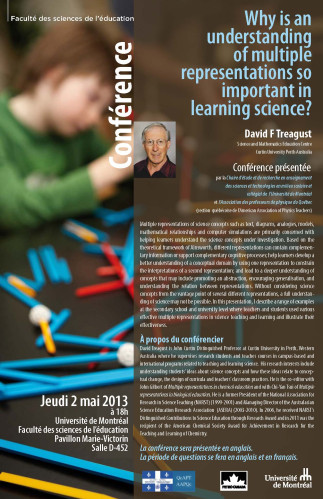Conférence présentée par David F. Treagust, Science and Mathematics Education Centre, Curtin University, Peth, Australie
RÉSUMÉ
Multiple representations of science concepts such as text, diagrams, analogies, models, mathematical relationships and computer simulations are primarily concerned with helping learners understand the science concepts under investigation. Based on the theoretical framework of Ainsworth, different representations can contain complementary information or support complementary cognitive processes; help learners develop a better understanding of a conceptual domain by using one representation to constrain the interpretations of a second representation; and lead to a deeper understanding of concepts that may include promoting an abstraction, encouraging generalisation, and understanding the relation between representations. Without considering science concepts from the vantage point of several different representations, a full understanding of science may not be possible. In this presentation, I describe a range of examples at the secondary school and university level where teachers and students used various effective multiple representations in science teaching and learning and illustrate their effectiveness.
Les représentations multiples de concepts scientifiques, comme des textes, diagrammes, analogies, modèles, les relations mathématiques et les simulations sur ordinateur s’intéressent principalement à fournir de l'aide aux étudiants pour comprendre les concepts à l'étude. Selon le cadre théorique d'Ainsworth, les différentes représentations peuvent renfermer de l'information additionnelle ou soutenir des processus cognitifs complémentaires; elles peuvent aider les étudiants à développer une meilleure compréhension d'un domaine conceptuel en employant une représentation pour contraindre les interprétations d'une deuxième représentation; ou encore, mener à une compréhension plus approfondie des concepts en favorisant l'abstraction et la généralisation, ainsi que la relation même entre les représentations.
Une compréhension complète des concepts scientifiques nécessite fort probablement la considération de ces concepts du point de vue de plusieurs représentations. Le conférencier David Treagust va décrire des exemples, aux niveaux préuniversitaire et postsecondaire, dans lesquelles les professeurs et les étudiants ont employé diverses représentations multiples dans l'enseignement et l'étude de la science. Il fera une illsutration de leur efficacité.
Cette conférence est organisée par la Chaire d'étude et de recherche en enseignement des sciences et technologies en milieu scolaire et collégial de l'Université de Montréal et l'Association des professeurs de physique du Québec (section québécoise de l’American Association of Physics Teachers)
David Treagust is John Curtin Distinguished Professor at Curtin University in Perth, Western Australia where he supervises research students and teaches courses in campus-based and international programs related to teaching and learning science. His research interests include understanding students’ ideas about science concepts and how these ideas relate to conceptual change, the design of curricula and teachers’ classroom practices. He is the co-editor with John Gilbert of Multiple representations in chemical education and with Chi-Yan Tsui of Multiple representations in biological education . He is a former President of the National Association for Research in Science Teaching (NARST) (1999-2001) and Managing Director of the Australasian Science Education Research Association (ASERA) (2003-2010). In 2006, he received NARST’s Distinguished Contributions to Science Education through research Award and in 2011 was the recipient of the American Chemical Society Award for Achievement in Research for the Teaching and Learning of Chemistry.
La conférence sera présentée en anglais.

